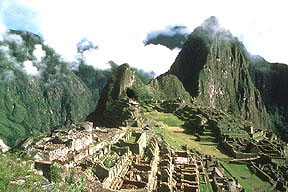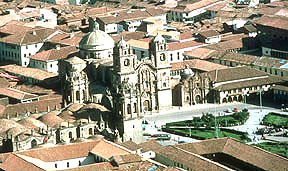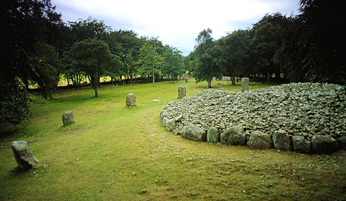This painting by George Catlin shows a young Native American boy. His ancestors were the first skywatchers of North America.
Click on image for full size
Image courtesy Corel Photography
The Skywatchers of the Americas
Early man would not have been distracted by t.v., video games, city lights or any of the things that keep us from spending our nights looking up at the black, starry sky. Long before farming, man would have watched the cycle of
the Sun because that cycle told them when plants would be ready for picking and when animals would be around to be hunted. And so we see that even the earliest man would have
watched the day and night sky.
Humans first lived in present-day Africa and the Middle East. These early hunter-gatherers roamed through Europe and Asia. It is thought that from Asia, people crossed the Bering Strait into North America while the straight was frozen over. There is so much evidence to support this theory that many people accept it as the way that the Americas came to be populated by humans. By 30,000 B.C., people were present in the Yukon. These hunter-gatherers just kept roaming the land perhaps following animals or water sources so that by 12,000 years ago, people were as far south as Argentina!
It is these people who were the Natives of the Americas. They too watched the sky. It is interesting to look at evidence of that skywatching by looking at the ancient astronomy practiced by the Native Americans of North America, the Maya of Central America and the Inca of South America.
You might also be interested in:

People from Asia crossed the Bering Strait into North America. These people were first in this new land and so they are known as Native Americans. Over time, these people broke into tribes (as seen on
...more
Peru's new president, Alejandro Toledo, was sworn in on July 28, 2001. The next day he visited Machu Picchu and Cuzco. There were ceremonies at both locations where Toledo asked for the blessing of the
...more
Cuzco is located in Southern Peru. It is the ancient capital of the Inca Empire. It is the oldest, continuously occupied city in the Americas. In ancient times, Cuzco was the ceremonial capital and hub
...more
"The movements of the heavenly bodies are an admirable thing, well known and manifest to all peoples. There are no people, no matter how barbaric and primitive, that do not raise up their eyes, take note,
...more
The stones of Carnac, France, are probably the most famous stones markings outside of those found at Stonehenge in England. There are many, many stones at Carnac. And these stones are very old too, the
...more
Not too far from Loch Ness, there lies three giant tombs made of stones. They are called the Balnuaran of Clava. The Balnuaran of Clava, giant tombs encased in stone, can be found close to Inverness in
...more
The stone structures of England and France are very famous. In Italy, you'll also find standing stones, stone rings, and stone tombs. An example of these stone structures is in Fossa, Abruzzo, in Italy.
...more















